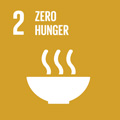- Docente: Paolo Bosi
- Credits: 7
- SSD: AGR/18
- Language: Italian
- Moduli: Paolo Bosi (Modulo 1) Paolo Trevisi (Modulo 2)
- Teaching Mode: Traditional lectures (Modulo 1) Traditional lectures (Modulo 2)
- Campus: Bologna
- Corso: First cycle degree programme (L) in Animal Production (cod. 8882)
Learning outcomes
The student should
- have the skills to make the necessary choice of concentrate feeds, forages, and other feedstuffs, on the base of principal characteristics and anti-nutritional compounds;
- be able to understand the indications dealing with the feeding requirements of domestic animals, adapting them to the different productive phases and the effective feed intake capacity;
- be able to calculate the digestibility of a diet, the energy value and the protein value;
- be able to predict the effect of the main processing's on the nutritive value of the feeds;
- know the main aspects of feed legislation.
Course contents
The nutrients: biochemistry, digestion, absorption, metabolism, and presence in the feeds.
Digestibility: measures, variations, improvements. The partition of the energy from the diet. Proteins: quality, efficiency of use in monogastrics and ruminants. The voluntary feed intake: controls. General criteria for the estimation of nutrient requirements for the different productions. The most common feeds. Antinutritional components in feeds. The additives: Basis of preparation and formulation of diets and feed compounds. Elements of legislation.Readings/Bibliography
Power point collection
ANTONGIOVANNI M., GUALTIERI M. Nutrizione e alimentazione animale, Il Sole 24 Ore Edagricole, Bologna, 1998.
ANTONGIOVANNI M. Nutrizione degli animali in produzione zootecnica, Edagricole, Bologna, 2004.
In English:
Basic Animal Nutrition and Feeding, 5th Edition, Wilson G. Pond, David B. Church et al., WileyCDA, December 2004
INRA feeding system for ruminants, Wageningen Academic. Editors: Daniel Sauvant, Luc Delaby, Pierre Nozière, Published: 2017 Pages: 300 ISBN: 978-90-8686-292-4
Teaching methods
Based on front classes, exercises at black-board and in the lab, visits to feed compound manufactures and farms, short applications on an electronic program for feed formulation
Assessment methods
The assessment is oral and is aimed at the assessment of the acquisition of knowledge in the program of the course. The evaluation is organizid in general on three questions: concepts of base nutrition and metabolism; characteristics of a category of feed; the rest of the program. The final mark, expressed by a score of maximum thirty, weights equally the evaluation obtained on each of the three questions.
Students wishing to take the exam in English must request it to the teacher at least two days before the exam.
Teaching tools
Power point slides, teaching program for diet formulation, animal science lab.
Office hours
See the website of Paolo Bosi
See the website of Paolo Trevisi
SDGs

This teaching activity contributes to the achievement of the Sustainable Development Goals of the UN 2030 Agenda.
